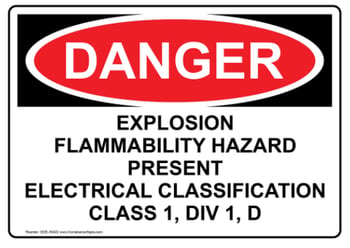Control Systems Part 1: Defining Hazardous Areas
 There are many factors that need to be considered when integrating a control system with a pneumatic conveying system (or any type of system for that matter). When designing a control system, one of the first considerations must be, “Where will it be installed?” This is because the National Electric Code (NEC) classification of the area in which the control panel(s) will be located dictates how the system must be designed and installed.
There are many factors that need to be considered when integrating a control system with a pneumatic conveying system (or any type of system for that matter). When designing a control system, one of the first considerations must be, “Where will it be installed?” This is because the National Electric Code (NEC) classification of the area in which the control panel(s) will be located dictates how the system must be designed and installed.
Since most conveying systems that De Dietrich Process Systems (DDPS) designs, builds and installs are suitable for operation in a “Hazardous Area”, we will be focusing on these types of areas rather than those classified as “Safe” or General Purpose” areas. There are multiple types/levels of hazardous area ratings, so the first step is to understand how they are categorized.
Based on the National Electrical Code® (NEC), there are three primary classifications that define the materials and conditions that will be present in the surrounding atmosphere. These area ratings thus determine the design requirements and required protection techniques and methods for the control system. They are:
- Class (this defines the general nature of material)
- Division (this defines the probability of material being present)
- Group (this defines the type of material)
Each of these categories is sub-divided as shown in the following table:
| Class | Division | Group |
| I, II, III (1, 2, 3) | I, II (1, 2) | A, B, C, D, E, F, G |
Following are more detailed descriptions of each Class & Division combination:
- Class 1 locations denote areas in which flammable gases, flammable liquid-produced vapors, or combustible liquid-produced vapors are or may be present in the air in quantities sufficient to produce explosive or ignitable mixtures.
- Class 1, Division 1 are areas where ignitable concentrations of flammable gases, flammable liquid-produced vapors, or combustible liquid-produced vapors can exist under normal operating conditions.
- Class 1, Division 2 describes areas where volatile flammable gases, flammable liquid-produced vapors, or combustible liquid-produced vapors are handled, processed, or used, but in which the liquids, vapors, or gases will normally be confined within closed containers or closed systems from which they can escape only is case of accidental rupture or breakdown of such containers or systems or in case of abnormal operation of equipment.
- Class 2 locations are identified as hazardous due to the presence of combustible dust.
- Class 2, Division 1 represents areas where combustible dust is in the air under normal operating conditions in quantities sufficient to produce explosive or ignitable mixtures.
- Class 2, Division 2 specifies an area where combustible dust due to abnormal operations may be present in the air in quantities sufficient to produce explosive or ignitable mixtures.
- Class 3 locations are hazardous due to easily ignitable fibers or where materials producing combustible flyings are handled, manufactured, or used.
- Class 3, Division 1 defines an area where easily ignitable fibers/flyings are handled, stored or used in a manufacturing process.
- Class 3, Division 2 indicates an area where easily ignitable fibers or flyings are stored or handled, but not used in a manufacturing process.
In addition to Class and Division, hazardous areas are also identified and broken down by Groups. Again, this category is used to distinguish the type of material that is, or might be present in the surrounding atmosphere and consists of the following designations:
|
Class |
Group |
Description |
|
Class 1 |
Group A |
Acetylene |
|
Group B |
Flammable gas, flammable liquid-produced vapor, or combustible liquid-produced vapor mixed with air that may burn or explode, having either a maximum experimental safe gap (MESG) value less than or equal to 0.45 mm or a minimum igniting current ratio (MIC ratio) less than or equal to 0.40. |
|
|
Group C |
Flammable gas, flammable liquid-produced vapor, or combustible liquid-produced vapor mixed with air that may burn or explode, having either a maximum experimental safe gap (MESG) value greater than 0.45 mm and less than or equal to 0.75 mm, or a minimum igniting current (MIC) ratio greater than 0.40 and less than or equal to 0.80. |
|
|
Group D |
Flammable gas, flammable liquid-produced vapor, or combustible liquid-produced vapor mixed with air that may burn or explode, having either a maximum experimental safe gap (MESG) value greater than 0.75 mm or a minimum igniting current (MIC) ratio greater than 0.80. |
|
|
Class 2 |
Group E |
Atmospheres containing combustible metal dusts, including aluminum, magnesium, and their commercial alloys, or other combustible dusts whose particle size, abrasiveness, and conductivity present similar hazards in the use of electrical equipment. |
|
Group F |
Atmospheres containing combustible carbonaceous dusts that have more than 8 percent total entrapped volatiles or that have been sensitized by other materials so that they present an explosion hazard. Coal, carbon black, charcoal, and coke dusts are examples of carbonaceous dusts. |
|
|
Group G |
Atmospheres containing combustible dusts not included in Group E or Group F, including flour, grain, wood, plastic, and chemicals. |
The information above comes directly from the National Electrical Code (NEC). For more information, please feel free to reach out to us or consult the NEC.
When designing a control system, one of the first questions should be, “What is the Electrical Area Classification into which it will be installed?” Using the above references as a guideline, you should now understand what an area’s classification means (for example, Class 1, Division 2, Group C & D). Knowing and understanding an area’s classification is a critical step toward ensuring the safe and successful operation of your system.
In part 2 of this post, we will provide some examples of powder handling solutions and other types of integrated unit operations that feature control systems we’ve built and designed that are suitable for several of these types of areas, detailing the various options available. In addition, we will provide further information about the different types of enclosures available and the areas in which they are suitable for use.
